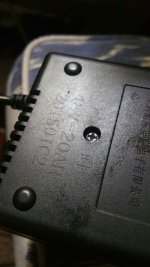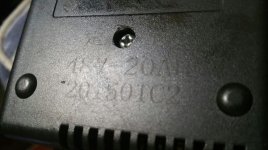SwampDonkey said:
I thought the same thing, so I checked with my backup, and grabbed a fresh battery.
Backup what?
Fresh ebike battery? Or battery for meter?
It's very important to be absolutely clear when saying what you are doing to troubleshoot, or we can't know what you're doing so we can help, without asking a lot of questions (which most people won't answer, so we cna't really help them).
The admittedly cheap AF charger is putting out 58.8V, though its marked as "48V 20Ah"
Well, a charger hasn't got an Ah rating, so no idea what that means.
But a 58.8V final votlage would be correct for a 14s "52v" pack (sometimes called 48v).
So you should re-measure all your cells, right now, and list them here starting with most negative, up to most positive, because it is impossible for them all to be as high as you say, if the charger itself is not that high a voltage--the voltage has to come from somewhere.
If you have more than one voltmeter, I strongly recommend measuring once with one of htem, then redo the measurements with the other. They should be very close; if there is a significant difference then one of the meters is problematic (usually it's battery is low). You may need a third meter to see which one is closer to it.
It looks like the BMS allows the battery to charge to the full voltage of the charger, then bleeds down cells that are too high. It gets pretty warm during charging.
If the pack is well balanced, then it does not need to bleed any cells at all, the final cell votlage would all be equal, and total up to the same as the charger voltage.
But the warm part is normal, if it is balancing.
IF the charger were too high a voltage, the BMS would (if working correctly) shut off charge current as soon as the first cell reached the HVC point, which is usually 4.2v for most non-LiFePO4 / non-LTO chemistries (except NMC that is usually 4.15v). So even a defective charger wouldn't be able to overcharge a battery with a working BMS.
Another charger I have stops at 54V.
THat is completely normal for a 13s pack (48v).
So we had 2 failures here. The BMS and the charger. I
We actually don't know if you have had ANY failures yet.
Recheck all the cell voltages, and list htem all here, from most negative first, to most positive.
Then run the pack down a fair bit, then remeasure all the cells and list them here. If possible, measure *during* the discharge as well.
Then put the pack back on the charger, and remeasure all the cells and list htem here, *while it is charging*, immediately after starting the charge.
Keep remeasuring and listing htem here every few minutes during the charge process.
When the charger first shuts off remeasure them and list tehm here again.
Repeat during balancing, as the cahrger restarts and shuts down again.
Then when the charger has finished charging and balancing, disconnect it, and leave the battery disconnected from any loads. Wait a day, then remeasure and list here again.
Doing these steps is necessary to knwo which, if any, cells are higher internal resistance than others, and greater or lesser capacity than ohters. It will also test the BMS for leaky channels draining cells, or BMS channels that are not correctly balancing cells.
If you don'[t do this, you wont' know what is actually wrong with the battery, if anything--you'll simply be guessing based on what seems to be impossible information (that is probably coming from a problematic voltmeter, test leads or connection problems).



